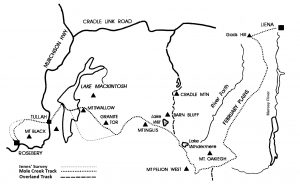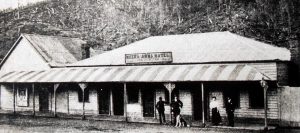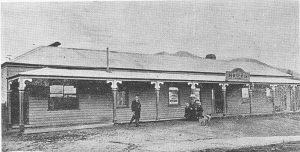Weather in the Tasmanian high country is unpredictable. The roaring 40s crash into the West Coast and spend themselves on the high mountains and plains. Rain, wind, storms and snow can come quickly at any time of the year. It catches the unprepared or unlucky. Sometimes it leaves death as its legacy. Each tragedy scars the lives of many people; family, friends and those who searched.
The death of T J Connolly in 1901 is one of many high country tragedies. Time has long ago erased the pain of his loss and it is little more than a sad, but well known, historic tale. Connolly deserves more than that. We should understand the person who died on the high plains and the heroic work of the searchers. It may be more than 110 years ago but it reminds us of the fallibility and strengths that are part of being human.
There is a long standing mystery about Connolly’s disappearance, a question first asked at the inquest into his death but never answered.[1] How could a person who knew the country disappear a few kilometres from his destination and reappear 20 kilometres away without being seen, or seeking help, on the busy track and huts in between? Finally, there is an answer.

In 1899, a well-made track finally opened the remote country south of Cradle Mountain. The Mole Creek Track worked its way over the high February Plains, across the foot of the mountains at the Pelion Plains, past Barn Bluff and west to Mount Farrell and Rosebery. Prospectors surged into the country. They found copper, gold, coal and tin. The areas around Barn Bluff and the Pelion Plains got the most attention. James Swallow was one of the busiest prospectors around Barn Bluff. He found copper in the valley of Commonwealth Creek and near Lake Windermere.
At Lake Windermere copper was in the rock exposed on the ridges, in the creeks and around the lake. It was good enough to peg a claim in February 1900.[2] Swallow also made a claim for his mate, publican Thomas James Connolly. Publicans, like store owners or business people, were often the silent partners of prospectors. They provided money, food and other support in exchange for the chance of a share of a rich mineral discovery. Connolly was also an active prospector.

Thomas Connolly was a man pushed along by the great currents of history. He and his brother Denis left Ireland for New Zealand and finally Australia and the opportunities that they offered. They became prospectors and merchants. In the early 1890s they rode the wave of a boom that centred around the two silver cities of western Tasmania, Zeehan and Dundas. These new born towns were carved from the rainforest, swamps and button grass plains and were homes of thousands of people. The Connollys built the Miners Arms Hotel in Dundas, ‘an attractive single story building’, just in time for the greatest financial failure of the time marked by the collapse of the Van Diemen’s Land Bank in August 1891.[3]
Thomas and Denis kept going for a while, unaware of the depth of the recession. Thomas joined the Dundas Town Board, helped organise St Patrick’s Day celebrations and wrote letters to the editor about politics and religion.[4] But he was slowly going out of business, just another person left gutted by the recession. By August 1892 he was a financial failure and by mid 1893 he disappeared from the town that he had put such effort into.[5]

Thomas drifted over the next few years. By 1896 he was in another emerging mining boom town, Kalgoorlie in Western Australia.[6] Somehow he found time to romance the daughter of the mayor of Bendigo, Agnes Carolin. In November 1895, in a lavish ceremony in Melbourne, he married Agnes and in a single step joined an influential dynasty; the Carolins of Bendigo and the Parers (his brother -in-laws were the prominent hoteliers Michael and John Arthur Parer) and William Higgins (a founder of Carlton and United Breweries) .[7] By early 1897 Connolly was back on the West Coast.[8]
Thomas and Agnes Connolly built the first hotel in the emerging town of Rosebery. The town was little more than a group of rough buildings; baker, butcher, stores and huts and tents that clustered around a muddy track that lead to the nearest railway at Ringville, about 10 kilometres away.[9] [10] Hotels were the focus of any emerging town; reasonable accommodation, food, drink and warmth. Connolly’s Rosebery hotel was lavish for a former financial failure. It was ‘a first class hotel … The probable cost of the building will exceed £1,500 and the furniture, recently purchased in Melbourne, cost a trifle over £400’.[11] It opened in August 1897.[12]
The Mole Creek Track was part of Connolly’s life for the four years he spent in Rosebery. His hotel was being built when surveyor Edward George Innes reached Rosebery to complete the survey of the track. It was made into a well-formed graded pack track in 1898 and 1899 when Rosebery boomed. It was the way that Connolly walked from Mount Farrell (now Tullah) to Barn Bluff.
By 1900 he and Agnes had two children; Marie Ellen and Eileen Agnes.[13] A hotel was important in a remote town and its owner was an important person too. Thomas was part of the business and civil community and a prospector on the side.[14] [15]

In March 1900, Thomas Connolly followed the Mole Creek Track from Rosebery to visit the claim made for him by James Swallow at Lake Windermere. He was impressed by the country in general and by his claim. Thomas probably stayed in James Swallow’s tent near the shores of the lake (near the current bushwalkers hut). He saw great potential. The ore body in the ridge was about 40 metres wide and could mined by tunnels driven into it. He picked up some coal samples from near Lake Holmes. Connolly could imagine a thriving mine and a railway to link it to North Mount Lyell.[16]
The next year, like every other, was busy for Connolly: politics; flower shows; forming a football club; the first wedding in Rosebery; Rosebery School prize giving.[17]
–
By 1901 the area around Barn Bluff was starting to take off. Hundreds of acres of mineral leases covered the country near Lake Windermere and north east near Commonwealth Creek. Most of the work was chipping a few samples from exposed rock or cutting a trench here and there. But the Barn Bluff Company leases along Commonwealth Creek were being worked hard. George Waller, Assistant Government Geologist was impressed. He called their work ‘vigorous’ and ‘most creditable’.[18] In a few months they cut 17 trenches and pits into the rock beside the creek. The promoters of the mine promised so much more.[19] Their camp was three tents. Nearby two men worked the North Barn Bluff mine, James Swallow and Thomas Cook.
A year after his first visit, on 19th March 1901, Thomas Connolly left the Rosebery Hotel for Barn Bluff to meet Swallow and Cook.[20] He wore his navy blue serge suit, cap and new water-tight boots and carried his bedding (two blankets and a rug) in a swag.[21] Connolly followed the familiar route of the newly made Mole Creek Track over Mount Black and walked along the Pieman River to Mount Farrell with Cornelius Madden (the publican of the Mount Farrell Hotel). Connolly seemed in no hurry. He bought some supplies and stayed the night.[22] Later some said that he had only enough food for a day, but he neatly recorded a list of supplies; tea, sugar, onions, a tin of milk, candles and three bottles of whiskey.[23] Some may have been supplies for Swallow. He also took a few loaves of bread.
At this stage there was no sign of trouble. Connolly was well prepared, he had sturdy clothing, his swag and provisions. He knew the country and the weather.[24] He never returned.
Next blog – the search for Connolly.
Ian Hayes & Peter Brown – copyright MountainStories.net.au 2019
[1] Zeehan and Dundas Herald,13 Dec 1901 p 4
[2] Daily Telegraph, 16 Mar 1900, page 4
[3] Zeehan and Dundas Herald, 10 Aug 1891, p 2
[4] Zeehan and Dundas Herald, 4 Sept 1891, p 2, 21 Sept 1891, p 2, 18 Mar 1892, Examiner 23 Aug 1892
[5] Mercury 18 Aug 1892, Zeehan and Dundas Herald 8 Mar 1893, 22 Aug 1893
[6] A TJ Connolly raised money for charity in Kalgoorlie (Western Argus 10 Sept 1896, p 34). Kalgoorlie also had a café and hotel owned by a member of the Parer family. Zeehan and Dundas Herald, 3 May 1897
[7] Bendigo Independent, 7 Dec 1895, p 2
[8] Zeehan and Dundas Herald, 3 May 1897 p 2
[9] Examiner 15 May 1897
[10] Examiner 21 December 1897
[11] Zeehan and Dundas Herald, 3 May 1897 p 2
[12] Zeehan and Dundas Herald, 1 September 1897
[13] The birth of another child is recorded in 1896 in Agnes’ maiden name. Names varied a lot. Connolly was also known as Connolly. Marie was also called Mary. Thomas was also called as James.
[14] Zeehan and Dundas Herald 22 Feb 1898 p 2
[15] Once Connolly raced his horse as part of a bet. A crowd of horsemen followed the two competitors along a main road in Zeehan though mud and rain. He was covered in mud and lost by 6 lengths Zeehan and Dundas Herald 2 May 1898
[16] Daily Telegraph 16 March 1900, page 4
[17] North West Advocate and Emu Bay Times, 15 Nov 1900, 5 Sept 1900, 15 Dec 1900, Examiner 31 Aug 1900, 12 Jun 1900, Zeehan and Dundas Herald, 6 Mar 1900, 19 Jun 1900,
[18] G Waller, Report on the Mineral Districts of Bell Mount, Dove River, Five Mile Rise, Mount Pelion and Barn Bluff, 3 April 1901
[19] The exuberance and optimism of EC James is legendary even embarrassed the most positive of prospectors and observers at the time.
[20] He had plans to float a company to mine the mineral leases at Barn Bluff, Bendigo Advertiser 14 Dec 1901, p 4
[21] Zeehan and Dundas Herald,13 December 1901 page 4; Tasmanian Archives and Heritage Office, Files Relating to the Administration of Intestate Estates, SC389/1/281, Agnes Connolly Statutory Declaration 6 Aug 1901.
[22] North Western Advocate and Emu Bay Times 4 April 1901, page 2
[23] North Western Advocate and Emu Bay Times 9 Dec 1901, p 2 the list stated gin but whiskey was found with his swag; Tasmanian Archives and Heritage Office, Files Relating to the Administration of Intestate Estates, SC389/1/281, Agnes Connolly Statutory Declaration 6 Aug 1901.
[24] He had been a prospector for 18 years, lived on the West Coast for at least 10 years.
Terrific work. Great narrative.
This is great, thanks for sharing the history. Denis Connolly is my great grandfather which I suppose makes Thomas my great uncle. Can’t wait for the next blog!!
Thanks so much for your comments. Denis was someone to be very proud of, for his interesting life, community spirit and being an important member of the Rosebery community for many years. We should acknowledge the help of Ben Parer and Brendan Connolly in preparing this series of blogs
Really pleased you are writing this, my brothers ,sisters and I have been intrigued by his story for years and my brother Ben has done some serious research into the family.
Thank you for the history into the mystery surrounding the death of my great uncle Thomas James Connolly. The story has intrigued our family for many years.
Thanks Jennifer, we are very pleased that your family has been so supportive of our little look into Thomas’ extraordinary life. Part 4 will be the last for a while but will answer a question that has intrigued us for a long time.